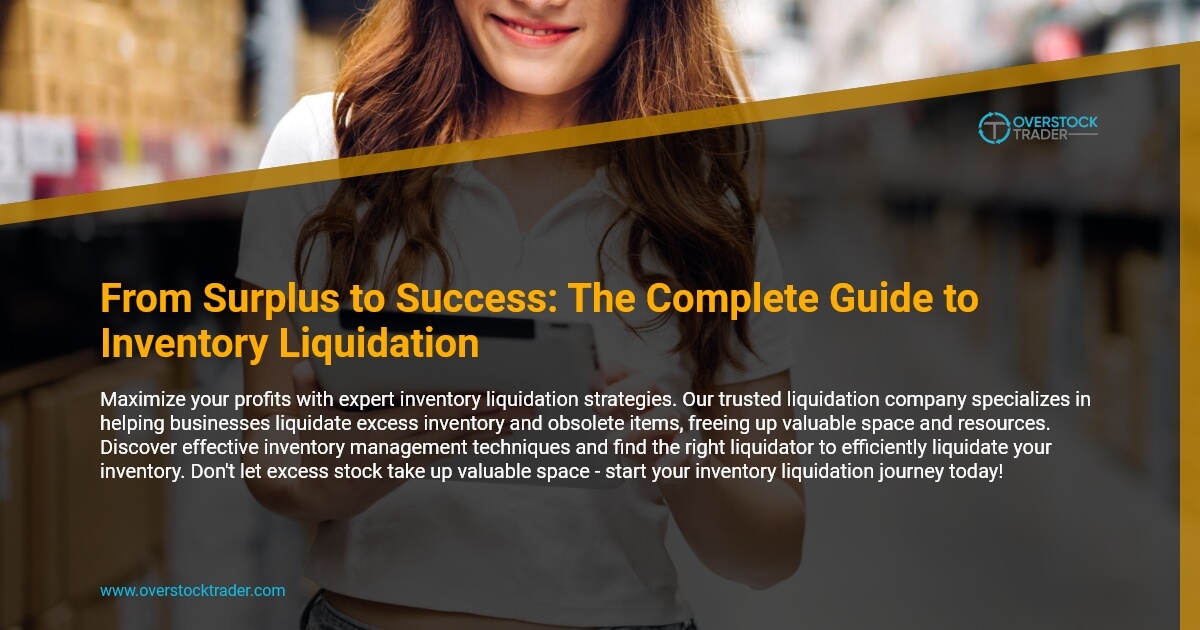Business inventory liquidation, the strategic process of converting excess or obsolete inventory into cash, plays a crucial role in optimizing business operations and profitability. By understanding the reasons for inventory liquidation, the methods used, and the effective strategies for planning, sales, logistics, and financial considerations, businesses can execute successful liquidation initiatives that minimize losses and maximize returns.
From planning and preparation to sales and marketing, this guide delves into the intricacies of business inventory liquidation, empowering businesses to navigate the process effectively. With insights from case studies and best practices, organizations can optimize their liquidation outcomes and unlock the full potential of their inventory management.
Business Inventory Liquidation
Business inventory liquidation refers to the process of selling off excess or obsolete inventory at reduced prices to clear space, generate cash, and reduce losses. It involves the disposal of unsold or slow-moving products to minimize their impact on a company’s financial performance and storage costs.
Reasons for Inventory Liquidation
- Excess inventory:When a business has more inventory than it can reasonably sell or store.
- Obsolete inventory:Products that are no longer in demand or have been replaced by newer models.
- Damaged or defective inventory:Products that cannot be sold due to damage or quality issues.
- Business closure or relocation:When a business is closing or moving to a new location and needs to liquidate its inventory.
li> Seasonal inventory:Products that are only sold during specific seasons and need to be cleared out after the season ends.
Methods of Inventory Liquidation
- Sales and discounts:Offering discounts, promotions, or clearance sales to encourage customers to purchase excess inventory.
- Bulk sales:Selling large quantities of inventory to wholesalers or other businesses at a discounted price.
- Online marketplaces:Selling inventory through online marketplaces such as Amazon or eBay.
- Liquidation companies:Hiring a liquidation company to manage the sale and disposal of excess inventory.
- Donation:Donating unsold inventory to charities or non-profit organizations.
Planning and Preparation: Business Inventory Liquidation

Effective inventory liquidation necessitates meticulous planning and preparation to ensure a successful outcome. This phase entails establishing clear goals, evaluating inventory, and assessing its value.
Setting Clear Goals and Objectives
Defining specific and measurable goals is crucial for a successful liquidation process. These goals should align with the overall business strategy and may include maximizing returns, reducing storage costs, or clearing obsolete inventory.
Preparing Inventory
Thoroughly preparing inventory involves organizing, counting, and categorizing all items. This includes creating a detailed inventory list that includes product descriptions, quantities, and condition. Accurate inventory data is essential for effective valuation and marketing.
Assessing Inventory Value
Determining the value of inventory is critical for setting realistic liquidation prices. This involves considering various factors such as market demand, product condition, and potential resale value. Accurate valuation ensures that the business receives fair compensation for its inventory.
Sales and Marketing Strategies

Sales and marketing play a crucial role in the success of inventory liquidation. Effective strategies can increase visibility, generate leads, and maximize revenue.Effective channels for promoting liquidated inventory include:
- Online marketplaces (e.g., eBay, Amazon)
- Liquidation websites (e.g., Liquidation.com, B-Stock)
- Social media platforms (e.g., Facebook, Instagram)
- Email marketing
Pricing strategies should consider factors such as market demand, competition, and the urgency of liquidation. Negotiating with buyers involves balancing the need for a quick sale with maximizing revenue.
Logistics and Fulfillment
Effective logistics and fulfillment are critical to the success of any inventory liquidation sale. Proper planning and execution ensure that liquidated inventory is stored, handled, and shipped efficiently while meeting customer expectations.
Inventory Storage
Proper storage is essential to preserve the condition of liquidated inventory and prevent loss or damage. Factors to consider include:
- Space requirements:Determine the amount of storage space needed based on the volume and type of inventory.
- Security:Implement measures to prevent theft, unauthorized access, and damage.
- Environmental conditions:Ensure proper temperature, humidity, and ventilation to prevent deterioration.
Inventory Handling
Careful handling is crucial to maintain the integrity of liquidated inventory. Key considerations include:
- Packing and shipping:Use appropriate packaging materials and shipping methods to protect items during transit.
- Loading and unloading:Train staff on proper handling techniques to prevent damage.
- Inventory management:Implement systems to track inventory levels and ensure efficient order fulfillment.
Customer Order Fulfillment
Efficient order fulfillment ensures timely delivery and customer satisfaction. Key steps include:
- Order processing:Establish clear processes for receiving, processing, and confirming customer orders.
- Shipping and tracking:Partner with reliable shipping carriers and provide tracking information to customers.
- Customer service:Provide prompt and responsive support to address customer inquiries and resolve any issues.
Returns and Exchanges, Business inventory liquidation
Clear return and exchange policies are essential for customer satisfaction. Consider the following:
- Return window:Establish a reasonable time frame for customers to return or exchange items.
- Return conditions:Specify the conditions under which returns or exchanges will be accepted.
- Refund or exchange process:Artikel the steps customers need to follow to initiate a return or exchange.
Financial and Legal Considerations
Inventory liquidation can have significant financial implications for businesses. It is crucial to carefully consider these aspects and seek professional advice if necessary.
Tax and Accounting Considerations
Inventory liquidation may trigger tax implications. Businesses should consult with tax professionals to understand the tax consequences of liquidation, such as capital gains or losses, and adjust their accounting records accordingly.
Legal Requirements and Compliance
There may be legal requirements and compliance issues associated with inventory liquidation, depending on the jurisdiction and the nature of the inventory. Businesses must comply with laws and regulations governing the disposal of goods, including environmental regulations and consumer protection laws.
Conclusion

In conclusion, business inventory liquidation is a multifaceted process that requires careful planning, execution, and financial acumen. By leveraging the strategies and best practices Artikeld in this guide, businesses can transform their excess inventory into valuable assets, improve cash flow, and enhance their overall financial performance.
Helpful Answers
What are the primary reasons for conducting business inventory liquidation?
Excess or obsolete inventory, seasonal changes, product discontinuation, and business closures are common reasons for inventory liquidation.
What are some effective sales channels for promoting and selling liquidated inventory?
Online marketplaces, auction platforms, liquidation companies, and retail outlets are effective channels for selling liquidated inventory.
How can businesses optimize pricing strategies for inventory liquidation?
Conducting market research, setting competitive prices, and offering discounts and promotions can help businesses optimize pricing strategies for inventory liquidation.
